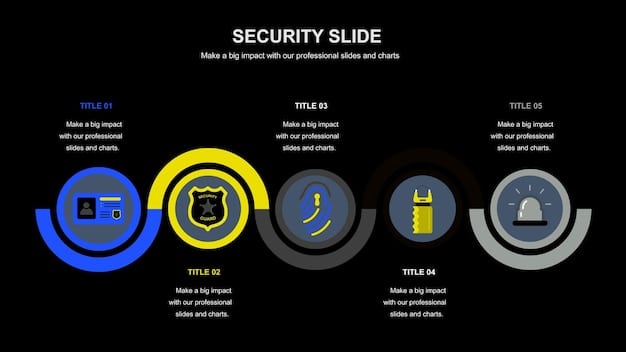NIST Cybersecurity Framework: A Practical 6-Step Implementation Guide

A practical cybersecurity guide explaining the NIST Cybersecurity Framework in 6 steps, providing organizations with a structured approach to assess and improve their cybersecurity posture.
In today’s digital landscape, organizations face an ever-increasing barrage of cyber threats. To navigate this complex terrain, the Cybersecurity Guide: Understanding and Implementing the NIST Cybersecurity Framework in 6 Steps offers a structured approach to assess and improve your cybersecurity posture. Let’s explore how to fortify your defenses and protect your valuable assets.
Understanding the NIST Cybersecurity Framework
The NIST Cybersecurity Framework (CSF) is a set of guidelines and best practices designed to help organizations manage and reduce cybersecurity risks. It is not a compliance mandate but a flexible framework adaptable to various industries and risk profiles.
The CSF provides a common language and structure for organizations to understand, manage, and communicate their cybersecurity risks, whether they are large corporations or small businesses.
The Core Components of the NIST CSF
The framework is structured around five core functions performing duties concurrently:
- Identify: Develop an organizational understanding to manage cybersecurity risk to systems, assets, data, and capabilities.
- Protect: Develop and implement appropriate safeguards to ensure delivery of critical infrastructure services.
- Detect: Develop and implement appropriate activities to identify the occurrence of a cybersecurity event.
- Respond: Develop and implement appropriate activities to take action regarding a detected cybersecurity incident.
- Recover: Develop and implement appropriate activities to maintain plans for resilience and to restore any capabilities or services that were impaired due to a cybersecurity incident.
Together, these functions provide a comprehensive cybersecurity lifecycle, enabling organizations to manage risk effectively. Each function is further divided into categories and subcategories, providing greater detail and granularity.

Understanding the framework’s structure is crucial for successful implementation. By systematically examining your organization’s cybersecurity practices against the CSF, you can identify gaps and prioritize improvements.
Step 1: Prioritize and Scope
Before diving into the NIST CSF, it’s crucial to define the scope and priorities for your cybersecurity efforts. This involves identifying the business objectives and critical assets that need protection.
Start by understanding what matters most to your organization. Which systems and data are essential for day-to-day operations and long-term success?
Defining Business Objectives
Clearly define your organization’s mission, objectives, and operational priorities. These will serve as the foundation for your scoping decisions.
- What are the most critical services your organization provides?
- Which systems and data are vital to supporting these services?
- What are the potential impacts of a cybersecurity incident on your business?
Answering these questions will help you prioritize your cybersecurity efforts and focus on protecting what matters most. Without this understanding, you risk wasting resources on less important aspects of your cybersecurity program.
Once you’ve identified your objectives, you can use them to guide your scoping decisions, ensuring that your cybersecurity efforts align with your overall business strategy. This is a critical step in making sure the framework is actually useful.
Step 2: Orient Yourself
The “Orient” phase involves gaining a comprehensive understanding of your current cybersecurity posture. This includes assessing existing risks, vulnerabilities, and security controls.
Start by taking stock of your current cybersecurity practices. What security measures are already in place, and how effective are they?
Conducting a Risk Assessment
A risk assessment is the cornerstone of the “Orient” phase. It involves identifying potential threats, vulnerabilities, and the likelihood and impact of a successful attack.
- Identify assets: List all systems, data, and resources that need protection.
- Identify threats: Determine potential threats that could exploit vulnerabilities.
- Identify vulnerabilities: Assess weaknesses in your systems and processes.
Focus on understanding your organization’s IT infrastructure, data management practices, and existing security controls. It involves evaluating the effectiveness of current security measures and identifying gaps that need to be addressed.
This step provides the foundation for making informed decisions about which areas of the CSF to prioritize. It also helps in understanding the current state of cybersecurity readiness and the level of effort required to achieve the desired target profile.

Step 3: Create a Current Profile
The next step is to create a “Current Profile,” which describes your organization’s existing cybersecurity capabilities and practices. This profile serves as a snapshot of your current state.
Map your current security activities to the CSF categories and subcategories. This will help you identify which areas are well-covered and which need improvement.
Documenting Existing Security Controls
Documenting your existing security controls can be an arduous task, but it is essential for creating an accurate current profile. This includes listing all policies, procedures, and technologies that contribute to your cybersecurity posture.
- Document all security controls: Detail the specific measures in place to protect your assets.
- Assess effectiveness: Evaluate how well each control is functioning and whether it is meeting its intended purpose.
This step allows you to understand where you stand in terms of cybersecurity readiness. Understanding your weak spots is essential for figuring out how to effectively utilize the CSF to your advantage.
A well-documented current profile provides a clear picture of your existing security posture, enabling you to identify gaps and prioritize areas for improvement. This is a crucial step in aligning your cybersecurity efforts with the CSF’s recommendations.
Step 4: Conduct a Risk Assessment
A comprehensive risk assessment is central to understanding your organization’s cybersecurity vulnerabilities. Doing this helps figure out which threats pose the greatest risk to your organization.
Identify potential threats that could exploit vulnerabilities in your systems and processes. Then, assess the likelihood and impact of a successful attack.
Assessing Vulnerabilities
Assessing vulnerabilities involves identifying weaknesses in your systems, applications, and processes that could be exploited by attackers. This can be achieved through vulnerability scans, penetration tests, and security audits.
- Conduct vulnerability scans: Use automated tools to identify known vulnerabilities in your systems.
- Perform penetration tests: Simulate real-world attacks to identify exploitable weaknesses.
A thorough risk assessment allows organizations to prioritize their cybersecurity efforts and allocate resources effectively. By focusing on the most significant risks, you can achieve the greatest impact with your available resources.
By understanding the risks your organization faces, you can make informed decisions about which areas to prioritize and how to allocate resources effectively. This is a critical step in ensuring that your cybersecurity efforts are aligned with your business objectives.
Step 5: Create a Target Profile
The “Target Profile” outlines your desired cybersecurity posture, aligned with your business objectives and risk tolerance. It represents the future state you aim to achieve.
Based on your risk assessment and business objectives, define the specific cybersecurity capabilities you want to achieve. Set realistic and measurable goals.
Aligning Security with Business Goals
Aligning security with business goals is essential for gaining buy-in from stakeholders and ensuring that cybersecurity efforts contribute to the overall success of the organization. This involves understanding the organization’s mission, objectives, and operational priorities.
- Define priorities: Identify security goals that support business objectives.
- Set measurable goals: Set specific and attainable targets for improvement.
Ensuring security is not just bolted-on to your business model, but a core part of its success is essential for a CSF to be truly useful.
A well-defined target profile provides a clear roadmap for improving your cybersecurity posture, enabling you to prioritize investments and track progress toward your goals. This is a critical step in ensuring that your cybersecurity efforts are aligned with your business objectives and risk tolerance.
Step 6: Determine, Analyze, and Prioritize Gaps
The final step is to analyze the gaps between your “Current Profile” and “Target Profile.” Identify areas where your existing security practices fall short of your desired state and prioritize improvements.
Compare your current and target profiles to identify the specific gaps that need to be addressed. Consider the resources required to close these gaps and prioritize based on risk and business impact.
Prioritizing Improvements
Prioritizing improvements involves ranking the identified gaps based on their impact on the organization’s risk profile and business objectives. This ensures that resources are allocated effectively to address the most critical vulnerabilities first.
- Rank gaps by impact: Prioritize improvements based on potential damage.
- Allocate resources effectively: Direct resources to address the most critical vulnerabilities.
It is important to consider budgetary constraints, regulatory requirements, and the availability of skilled personnel when prioritizing improvements. Addressing the right things in the right order based on your business.
This step provides a clear roadmap for improving your cybersecurity posture, enabling you to allocate resources effectively and track progress toward your goals. This is a critical step in ensuring that your cybersecurity efforts are aligned with your business objectives and risk tolerance.
| Key Aspect | Brief Description |
|---|---|
| 🛡️ Prioritize and Scope | Define business objectives and critical assets for protection. |
| 🔍 Orient Yourself | Understand your current cybersecurity posture and existing risks. |
| 🎯 Create a Target Profile | Outline your desired cybersecurity posture aligned with business goals. |
| 🚧 Analyze and Prioritize Gaps | Identify and prioritize the areas where your security practices fall short. |
Frequently Asked Questions
▼
The NIST Cybersecurity Framework (CSF) is a voluntary framework that helps organizations to manage and mitigate cybersecurity risks based on existing standards, guidelines, and practices.
▼
The NIST CSF enhances cybersecurity risk management, promotes communication across the organization, and improves alignment of cybersecurity activities with business goals and regulatory requirements.
▼
The framework is structured around five core functions—Identify, Protect, Detect, Respond, and Recover—which provide a high-level, strategic view of the cybersecurity lifecycle.
▼
No, the NIST Cybersecurity Framework is not mandatory for most private sector organizations. However, it is often used by government agencies and can be used as a benchmark for compliance.
▼
Yes, the NIST Cybersecurity Framework is scalable and adaptable, making it suitable for businesses of all sizes. Smaller businesses can focus on the most relevant and impactful aspects.
Conclusion
Implementing the NIST Cybersecurity Framework is a journey, not a destination. It requires ongoing effort and commitment to adapt to the evolving threat landscape. By following these six steps, organizations can establish a solid foundation for managing cybersecurity risks and protecting their valuable assets.





